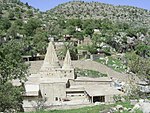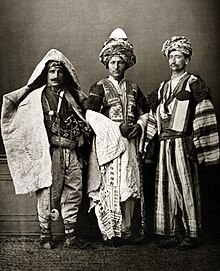Portal:Kurdistan/Selected article/2007
|
These articles have appeared on the Portal:Kurdistan page in 2007. They are (or were at the time of listing) Featured Articles.

The Republic of Mahabad (Kurdish: Komarî Mehabad, Persian: جمهوری مهاباد ), also known as Republic of Kurdistan, established in Iranian Kurdistan, was a short-lived, Soviet backed Kurdish state of the 20th century after the Republic of Ararat in Turkey. Its capital was the Kurdish city of Mahabad in northwestern Iran. The republic's founding and demise was a part of the Iran crisis, a conflict between USA and USSR, which was a precursor to the Cold War. More..
Kurdistan Uyezd (also known colloquially as Red Kurdistan from Kurdish Kurdistana Sor, Azerbaijani Qızıl Kürdistan, Russian Красный Курдистан) was a Soviet administrative unit that existed for six years from 1923 to 1929.[1] Its capital was Lachin (Laçîn in Kurdish). The presence of Kurds in today's Azerbaijan dated back to the 9th century. The presence of Kurds in today's Azerbaijan dated back to the 9th century. The area between Karabakh and Zangezur became inhabited by nomadic Kurdish tribes in the 18th century. Eventually, this population became the majority in most parts of the region, particularly around Lachin, Kalbajar (Kelbajar in Kurdish), and Qubadli (Qûbadlî in Kurdish). more
References
- ^ (in Russian) Russia and the problem of Kurds

The Yazidi or Yezidi (Kurdish: Êzidîtî or Êzidî)(Arabic,يزيدي or ايزيدي) are adherents of a Middle Eastern religion with ancient origins. Yazidi belong to the smallest of the three branches of Yazdânism. The other branches of Yazdânism, Alevism and Yarsanism, differ from Yazidism by recognizing the Islamic practice of taqiyya (dissimulation). The three branches are geographically split and mutual contacts are rare. Yazidis are primarily ethnic Kurds, and most live near Mosul, Iraq with smaller communities in Armenia (some 40,000 according to 2001 census), Georgia, Iran, Russia (31,273 as per 2002 census), Syria, and Turkey. Yazidi

Mount Ararat (Turkish: Ağrı Dağı, Armenian: Արարատ, Kurdish: Çîyayê Agirî, Greek: Ἀραράτ, Persian: آرارات, Russian: Арарат, Hebrew: אֲרָרָט, Tiberian Hebrew: ʾĂrārāṭ) is the tallest peak in Turkey. This snow-capped, dormant volcanic cone is located in the Iğdır Province, near the northeast corner of Turkey, 16 km (10 miles) west of the Iranian and 32 km (20 miles) south of the Armenian border. more
Portal:Kurdistan/Selected article/2007/July

The Kurds are an ethnic group who are indigenous to a region often referred to as Kurdistan, an area which includes adjacent parts of Iran, Iraq, Syria, and Turkey. Kurdish communities can also be found in Lebanon, Armenia, Azerbaijan (Kalbajar and Lachin, to the west of Nagorno Karabakh) and, in recent decades, some European countries and the United States (see Kurdish diaspora). Ethnically related to other Iranian peoples,[1] they speak Kurdish, an Indo-European language of the Iranian branch. However, the Kurds' ethnic origins are uncertain.[2]
According to Encyclopedia Columbia, Kurds are commonly identified with the ancient Corduene which was in turn inhabited by the descendants of the Carduchis.[3]
References

Lake Van (Turkish: Van Gölü; Armenian: Վանա լիճ; Kurdish: Gola Wanê) is the largest lake in Turkey, located in the far east of the country. it is a saline lake of volcanic origin with no outlet, receiving water from numerous small streams that descend from the surrounding mountains. It is 119 km across at its widest point, averaging a depth of 171 meters with a maximum depth of up to 451 meters. It has an area of 3,755 km² and is 1719 meters above sea level. The shore length of the lake is 430 kilometers.

The Kurds are an ethnic group who are indigenous to a region often referred to as Kurdistan, an area which includes adjacent parts of Iran, Iraq, Syria, and Turkey. Kurdish communities can also be found in Lebanon, Armenia, Azerbaijan (Kalbajar and Lachin, to the west of Nagorno Karabakh) and, in recent decades, some European countries and the United States (see Kurdish diaspora). Ethnically related to other Iranian peoples,[1] they speak Kurdish, an Indo-European language of the Iranian branch. However, the Kurds' ethnic origins are uncertain.[2]
According to Encyclopedia Columbia, Kurds are commonly identified with the ancient Corduene which was in turn inhabited by the descendants of the Carduchis. But Ethnically close to the Iranians.[3]
According to Britannica encyclopedia,The Persians, Kurds, and speakers of other Indo-European languages in Iran are descendants of the Aryan tribes that began migrating from Central Asia into what is now Iran in the second millennium BC[E]. [4]
References
- ^ Microsoft Encarta Online Encyclopedia, s.v. Iran, (by Eric Hooglund), section 3A (accessed 24 July 2006).
- ^ Encyclopædia Britannica Online, s.v. Kurds, (accessed 4 August 2006)
- ^ The Columbia Encyclopedia, s.v. http://www.bartleby.com/65/ku/Kurds.html Kurds], (accessed 17 July 2007)
- ^ Britannica encyclopedia, s.v. http://www.britannica.com/eb/article-9046466/Kurd,

The Kurds are an ethnic group who are indigenous to a region often referred to as Kurdistan, an area which includes adjacent parts of Iran, Iraq, Syria, and Turkey. Kurdish communities can also be found in Lebanon, Armenia, Azerbaijan (Kalbajar and Lachin, to the west of Nagorno Karabakh) and, in recent decades, some European countries and the United States (see Kurdish diaspora). Ethnically related to other Iranian peoples,[1] they speak Kurdish, an Indo-European language of the Iranian branch. However, the Kurds' ethnic origins are uncertain.[2]
According to Encyclopedia Columbia, Kurds are commonly identified with the ancient Corduene which was in turn inhabited by the descendants of the Carduchis.[3]
References

The Kurds are an ethnic group who are indigenous to a region often referred to as Kurdistan, an area which includes adjacent parts of Iran, Iraq, Syria, and Turkey. Kurdish communities can also be found in Lebanon, Armenia, Azerbaijan (Kalbajar and Lachin, to the west of Nagorno Karabakh) and, in recent decades, some European countries and the United States (see Kurdish diaspora). Ethnically related to other Iranian peoples,[1] they speak Kurdish, an Indo-European language of the Iranian branch. However, the Kurds' ethnic origins are uncertain.[2]
According to Encyclopedia Columbia, Kurds are commonly identified with the ancient Corduene which was in turn inhabited by the descendants of the Carduchis.[3]
